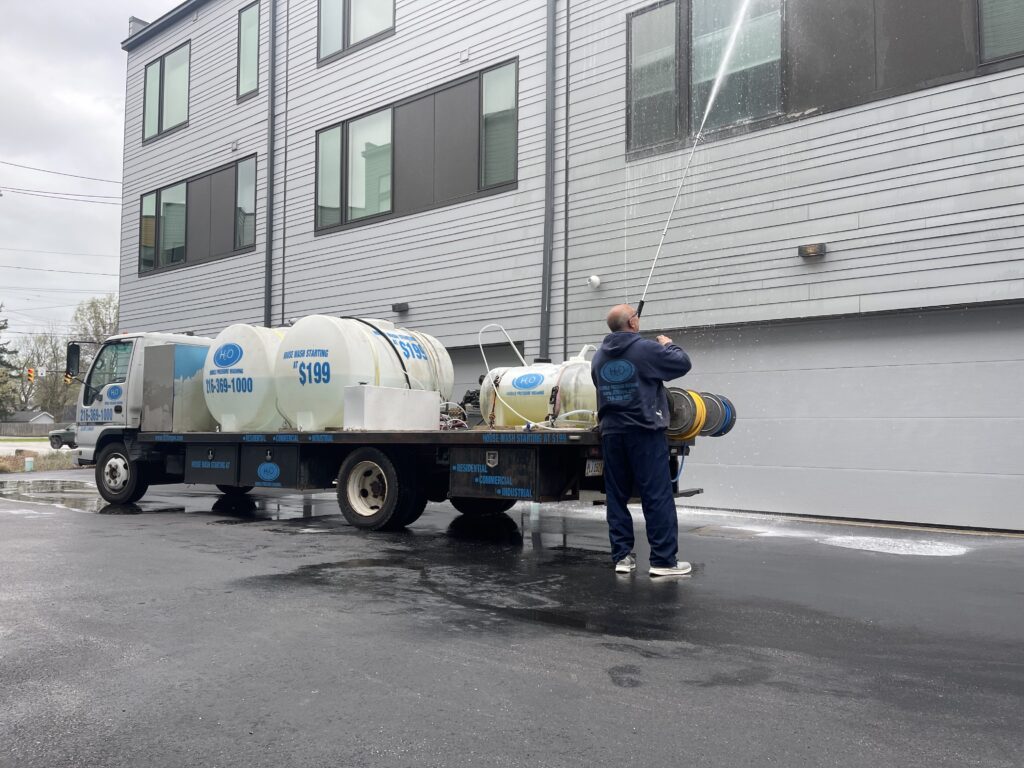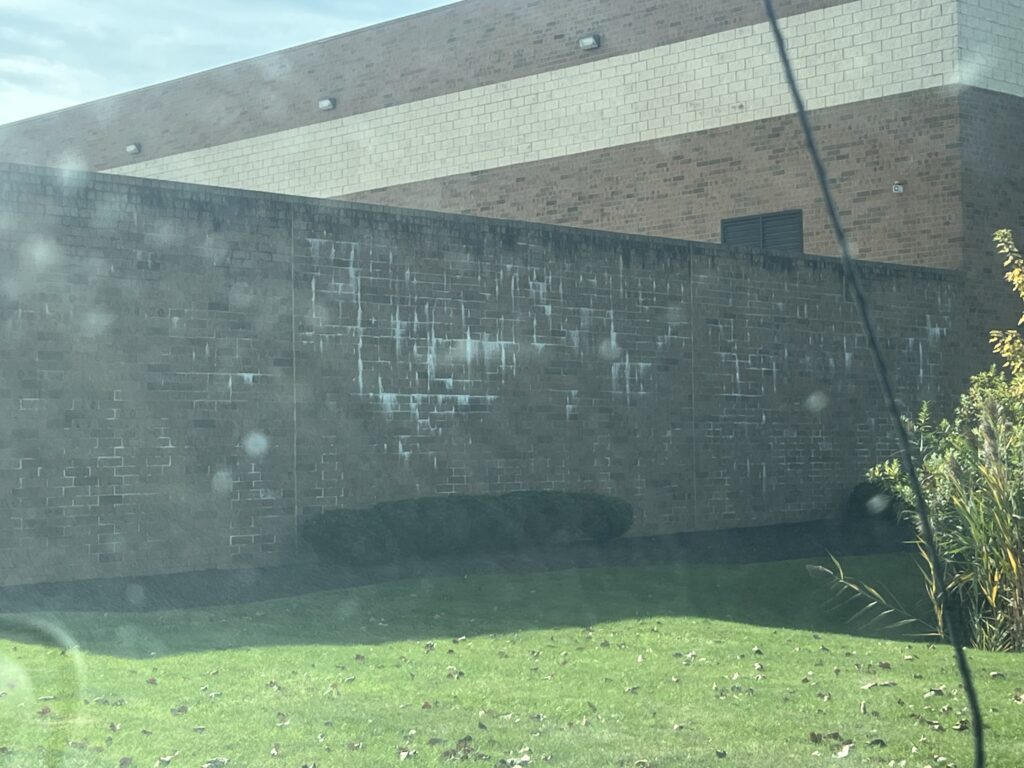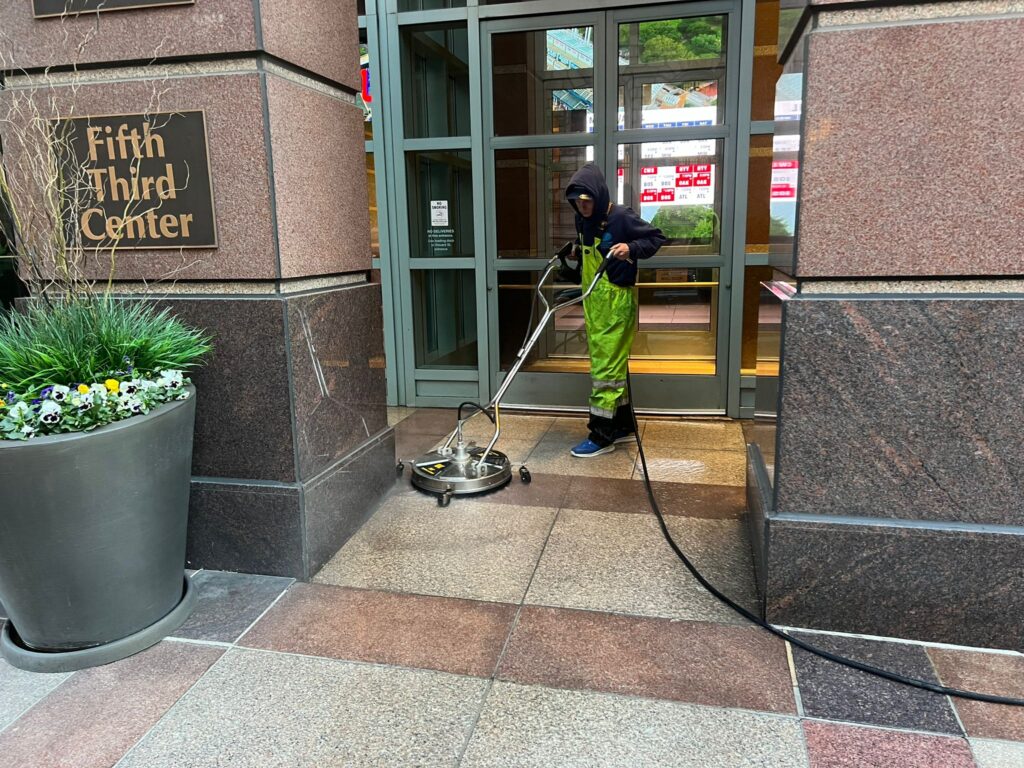
Building pressure washing is an essential aspect of property maintenance that extends well beyond surface cleaning. It involves the use of high-pressure water jets to eliminate dirt, grime, mold, and various contaminants from the exterior surfaces of buildings. This article explores the multifaceted benefits of pressure washing, emphasizing its critical role in preventing leaching and efflorescence, addressing atmospheric effects, ensuring the proper cleaning of stone surfaces, and maintaining structural integrity. By the end of this article, property owners and managers will appreciate why pressure washing is not just a cosmetic enhancement but a vital investment in their buildings’ longevity and health.
1. Enhancing Aesthetic Appeal and Property Value
1.1 Curb Appeal and First Impressions
The exterior of a building serves as its first impression to visitors, tenants, and potential buyers. Curb appeal plays a significant role in real estate and property management, directly influencing marketability and value. According to a study by the National Association of Realtors (NAR), homes with strong curb appeal can command prices 7% to 14% higher than comparable properties lacking visual appeal. A thorough pressure washing can revitalize a building’s appearance, effectively removing years of accumulated grime, stains, and discoloration.
The significance of curb appeal goes beyond aesthetics; it also reflects the overall maintenance and care that has gone into the property. Potential buyers often associate well-maintained exteriors with well-cared-for interiors. Conversely, a dirty or neglected exterior can lead to negative assumptions about the property’s condition.
1.2 Regular Maintenance vs. Reactive Cleaning
Regular pressure washing is an effective preventive maintenance strategy that reduces the need for extensive and costly repairs down the line. Property owners who adopt a proactive approach are likely to encounter fewer issues related to surface damage, mold growth, and degradation of materials, thus saving on future maintenance costs. In contrast, reactive cleaning often leads to more extensive damage that requires significant investments in repairs and restoration.
1.3 Case Studies Demonstrating Value Enhancement
Several studies illustrate the tangible benefits of regular pressure washing. For instance, a survey conducted by HomeGain revealed that homeowners who invested in pressure washing before selling their homes recouped an average of 105% of their costs at closing. In many cases, properties that received a thorough cleaning sold faster than comparable listings, underscoring the value of maintaining an appealing exterior.
2. Addressing Leaching and Efflorescence
2.1 Understanding Leaching
Leaching is the process by which water-soluble substances are washed out from building materials, particularly concrete and masonry. This phenomenon is often exacerbated by rainfall, where water carries salts, minerals, and other harmful substances from the surface into the material itself. Over time, leaching can lead to significant structural damage, including spalling, cracking, and overall deterioration.
According to the American Concrete Institute, leaching is a common problem in structures that are improperly maintained, leading to costly repairs and reduced lifespan of building materials.
2.2 The Challenge of Efflorescence

Efflorescence is characterized by the formation of white, powdery deposits on masonry surfaces, resulting from the migration of water-soluble salts to the surface as water evaporates. This not only detracts from a building’s appearance but can also signify underlying moisture problems that, if left unchecked, can lead to more severe structural issues.
Regular pressure washing is a critical preventive measure against efflorescence. By removing moisture and salt deposits from the surface, pressure washing helps to maintain the integrity of masonry materials. The Portland Cement Association advises incorporating pressure washing as part of routine maintenance to combat efflorescence and protect masonry structures.
2.3 Case Studies and Expert Opinions
Numerous case studies highlight the benefits of pressure washing in addressing leaching and efflorescence. For example, a study conducted by the National Association of Home Builders (NAHB) found that homes subjected to regular pressure washing experienced significantly lower rates of moisture-related damage compared to those that were not maintained. Experts in the field recommend including pressure washing as part of an annual maintenance checklist, particularly in regions prone to high humidity and precipitation.
2.4 Preventive Maintenance Strategies
In addition to regular pressure washing, property owners can take several preventive measures to mitigate the risks of leaching and efflorescence:
- Drainage Solutions: Installing proper drainage systems around the foundation can prevent water from pooling against walls, reducing the chances of moisture infiltration.
- Sealing Surfaces: Applying sealants to porous surfaces can help prevent water absorption and minimize the risks associated with leaching.
- Regular Inspections: Conducting routine inspections of exterior surfaces for signs of moisture infiltration or efflorescence can help catch problems early before they escalate.
3. Mitigating Atmospheric Effects
3.1 The Impact of Environmental Factors
Buildings are continuously exposed to various atmospheric conditions, including rain, wind, humidity, and pollution. These environmental factors contribute to the accumulation of dirt, algae, mold, and other contaminants, which can deteriorate building materials over time. According to the U.S. Environmental Protection Agency (EPA), mold growth can pose health risks, particularly for individuals with respiratory issues, allergies, or weakened immune systems.
3.2 Health Considerations
The presence of mold and mildew not only affects the building’s structural integrity but also creates an unhealthy living environment. Pressure washing effectively removes these harmful substances, thereby ensuring a healthier environment for occupants. In a report published by the EPA, it was noted that maintaining clean building exteriors is crucial for preventing indoor air quality issues, thus protecting the health of residents and employees. Regular cleaning can significantly reduce allergens and irritants, contributing to a safer and more pleasant indoor atmosphere.
3.3 Building Regulations and Compliance
In many regions, building codes and regulations mandate regular maintenance of commercial and residential properties to ensure safety and health standards are met. Failure to comply with these regulations can result in fines and penalties. Regular pressure washing can help property owners stay compliant with local building codes while also promoting a safer and healthier environment.
3.4 Impact of Pollution on Building Materials
In urban areas, buildings are subjected to pollutants, such as vehicle emissions, industrial discharges, and particulate matter, which can accumulate on surfaces. Over time, this pollution can lead to discoloration and degradation of materials. Pressure washing not only removes these pollutants but also prevents the formation of permanent stains that can diminish the value of the property.

4. Importance of Stone Cleaning
4.1 The Unique Challenges of Stone Surfaces
Natural stone surfaces, such as granite, marble, and limestone, add beauty and elegance to buildings but require specialized care due to their porous nature. Over time, these surfaces can accumulate dirt, organic matter, and biological growth, leading to discoloration and damage. The Natural Stone Institute emphasizes that proper cleaning and maintenance are essential for preserving the beauty and durability of stone surfaces.
4.2 The Role of Pressure Washing
Pressure washing is an effective method for cleaning stone surfaces as it can penetrate deep into the pores without damaging the material. However, it is vital to adhere to manufacturer recommendations and industry standards when pressure washing stone. Excessive pressure can lead to surface erosion and degradation, diminishing the stone’s aesthetic appeal and structural integrity.
4.3 Best Practices for Stone Cleaning
When pressure washing stone surfaces, consider the following best practices to achieve optimal results:
- Pressure Settings: The pressure setting should be adjusted according to the type of stone being cleaned. Softer materials, such as sandstone, require lower pressure (500-800 psi), while harder stones like granite can withstand higher pressures (up to 2,000 psi).
- Cleaning Agents: Use eco-friendly and biodegradable cleaning agents specifically formulated for stone surfaces. Avoid harsh chemicals that can cause discoloration or damage. The Natural Stone Institute provides guidelines on suitable cleaning agents for various types of stone.
- Testing and Evaluation: Before conducting a full-scale cleaning, it is advisable to perform a test on a small, inconspicuous area to evaluate the effectiveness of the pressure washing technique and cleaning agent.
4.4 Professional vs. DIY Pressure Washing
While DIY pressure washing can be tempting, particularly for homeowners looking to save money, professional services often provide superior results. Professionals are equipped with advanced equipment and knowledge of the right techniques for different materials. They can assess the condition of surfaces, identify areas that require special attention, and ensure that the pressure washing process does not cause damage. Moreover, they adhere to safety protocols that mitigate risks associated with pressure washing, ensuring a thorough and safe cleaning process.
5. Manufacturer Recommendations
Adhering to manufacturer recommendations is crucial for successful pressure washing. Here are some guidelines to consider:
- Equipment Selection: Choose the right pressure washer for the job. Electric pressure washers are generally suitable for residential applications, while gas-powered models are more effective for larger commercial projects. When purchasing equipment, refer to manufacturers’ specifications regarding maximum pressure and flow rates to ensure compatibility with various cleaning tasks.
- Nozzle Selection: Different nozzle types provide varying spray patterns and pressures. A wider spray angle (25-40 degrees) is generally safer for delicate surfaces, while a narrower angle (0-15 degrees) is more effective for tough stains. Each nozzle serves a specific purpose, and using the appropriate one can enhance cleaning effectiveness while minimizing damage.
- Maintenance of Equipment: Regular maintenance of pressure washing equipment is vital to ensure optimal performance. This includes checking hoses, nozzles, and engines, as well as cleaning filters to prevent clogs. Refer to the manufacturer’s maintenance guidelines to prolong the life of the equipment and maximize its effectiveness.
5.1 Safety Precautions
Safety should always be a priority during pressure washing. Operators should wear appropriate personal protective equipment (PPE), including:
- Safety Goggles: To protect eyes from flying debris and chemical splashes.
- Gloves: To protect hands from chemicals and abrasions.
- Non-Slip Footwear: To prevent slips and falls on wet surfaces.
Additionally, it is essential to ensure that the area is clear of obstructions and that individuals not involved in the cleaning process maintain a safe distance.
6. Conclusion

Building pressure washing is an indispensable practice that significantly contributes to property maintenance and value enhancement. By addressing issues related to leaching and efflorescence, mitigating atmospheric effects, ensuring proper stone cleaning, and adhering to manufacturer recommendations, pressure washing helps protect the integrity of buildings while promoting a healthy environment for occupants.
Property owners and managers are encouraged to incorporate regular pressure washing into their maintenance schedules to maximize the lifespan of their buildings and prevent costly repairs. Moreover, engaging professional pressure washing services can yield superior results, ensuring that properties remain clean, safe, and appealing.
References
- National Association of Realtors. “Impact of Curb Appeal on Property Values.” NAR.
- American Concrete Institute. “Leaching and Its Effects on Concrete.” ACI.
- Portland Cement Association. “Masonry Maintenance: Cleaning and Repair.” PCA.
- Concrete Network. “What Is Efflorescence and How to Remove It.” Concrete Network.
- National Association of Home Builders. “Impact of Preventive Maintenance.” NAHB.
- U.S. Environmental Protection Agency. “Mold and Moisture Control.” EPA.
- Natural Stone Institute. “Cleaning Natural Stone.” NSI.
- Cleaning Industry Research Institute. “Best Practices for Pressure Washing.” CIRI.
- OSHA. “Safety and Health for Pressure Washers.” OSHA.
- Natural Stone Institute. “Care and Maintenance of Natural Stone.” NSI.
- The Stone Trust. “The Benefits of Pressure Washing for Stone.” Stone Trust.
- Pressure Washers Direct. “Guide to Pressure Washer Nozzles.” Pressure Washers Direct.
- HomeAdvisor. “Cost to Pressure Wash a House.” HomeAdvisor.
- Angie’s List. “How to Maintain Stone Surfaces.” Angie’s List.
- The Cleaning Institute. “Cleaning Methods and Techniques for Pressure Washing.” Cleaning Institute.
By emphasizing the necessity of building pressure washing and highlighting the risks of neglect, this article aims to provide property owners and managers with a comprehensive understanding of the importance of maintaining clean, safe, and aesthetically appealing buildings. Regular pressure washing not only enhances property value but also safeguards the health of occupants, ultimately contributing to a more sustainable and resilient built environment.
